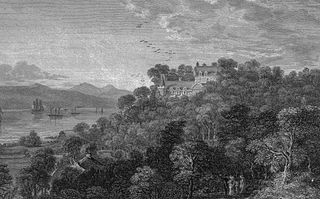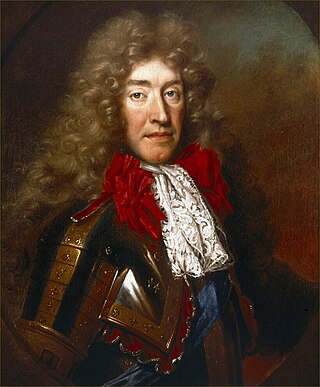Related Research Articles
George Gordon, 1st Earl of Aberdeen, was a Lord Chancellor of Scotland.
Charlwood Lawton (1660–1721) was an English lawyer and phrase-making pamphleteer, a Whig of Jacobite views. He invented the term "Whiggish Jacobite", used to point out the difference between those who shared his opinions, and the nonjuror faction. After the Battle of La Hogue of 1692, the exiled James II of England became more receptive to Lawton's range of arguments. Lawton promoted "civil comprehension", i.e. the removal of all religious tests for the holding of public office. He was a prolific author of subversive literature, to whom some uncertain attributions are made. He is credited with the concept that the Glorious Revolution was a constitutional charade that fell short of its ideals.

John Murray, 1st Duke of Atholl, KT, PC was a Scottish nobleman, politician, and soldier. He served in numerous positions during his life, and fought in the Glorious Revolution for William III and Mary II.
The Bannatyne Club, named in honour of George Bannatyne and his famous anthology of Scots literature the Bannatyne Manuscript, was a text publication society founded by Sir Walter Scott to print rare works of Scottish interest, whether in history, poetry, or general literature. The club was established in 1823 and printed 116 volumes before being dissolved in 1861.

William Gordon, 6th Viscount of Kenmure and Lord Lochinvar was a Scottish Jacobite.
Sir James Melville (1535–1617) was a Scottish diplomat and memoir writer, and father of the poet Elizabeth Melville.

William Herbert, 1st Marquess of Powis, PC KG (1626 – 2 June 1696) was an English nobleman, best remembered for his suffering during the Popish Plot. He succeeded his father as 3rd Baron Powis in 1667 and was created Earl of Powis in 1674 by King Charles II and Viscount Montgomery, of the Town of Montgomery, and Marquess of Powis in 1687 by King James II, having been appointed to the Privy Council in 1686.

Clan Cunningham is a Scottish clan. The traditional origins of the clan are placed in the 12th century. However, the first contemporary record of the clan chiefs is in the thirteenth century. The chiefs of the Clan Cunningham supported Robert the Bruce during the Wars of Scottish Independence. In the 15th and 16th centuries, the Clan Cunningham feuded with the Clan Montgomery. Historically, the chief of Clan Cunningham held the title of Earl of Glencairn. However, in modern times the chief of the clan is Cunningham of Corsehill. On 18 December 2013, Sir John Christopher Foggo Montgomery Cunninghame, Baronet of Corsehill, was recognized by Lord Lyon as Clan Chief after the chiefship had been vacant for over 200 years.

Clan Montgomery is a Scottish clan of the Scottish Lowlands.

The Hales Baronetcy, is a title in the Baronetage of England. There were three Hales baronetcies. The oldest was created in 1611 for Edward Hales. He was a member of a Kent family. The second was created in 1660 for Robert Hales, MP for Hythe 1659, also of a Kent family. The third was created in 1660 for John Hales of Coventry, co. Warwick.

Richard Graham, 1st Viscount Preston PC was an English diplomat and politician who sat in the House of Commons in two periods between 1675 and 1689. He became a Jacobite conspirator, but his reputation in the Jacobite community suffered when he gave evidence against his co-conspirators in exchange for a pardon.
Colin Lindsay, 3rd Earl of Balcarres (1652–1722) was a Scottish aristocrat and politician, one of the most important supporters of James II of England.

Skelmorlie Castle stands on the eastern shore of the Firth of Clyde, Scotland, at the north-western corner of the county of Ayrshire. The structure dates from 1502, and was formerly the seat and stronghold of the Montgomery Clan. The modern village of Skelmorlie lies to the north of the castle.

Edward Wotton, 1st Baron Wotton (1548–1626) was an English diplomat and administrator. From 1612 to 1613, he served as a Lord of the Treasury. Wotton was Treasurer of the Household from 1616 to 1618, and also served as Lord Lieutenant of Kent from 1604 until 1620.
William Ross, 12th Lord Ross, was a Scottish nobleman, soldier and politician.
George Livingston PC was a military officer and third Earl of Linlithgow.

The Glorious Revolution in Scotland refers to the Scottish element of the 1688 Glorious Revolution, in which James VII was replaced by his daughter Mary II and her husband William II as joint monarchs of Scotland and England. Prior to 1707, the two kingdoms shared a common monarch but were separate legal entities, so decisions in one did not bind the other. In both countries, the Revolution confirmed the primacy of Parliament over the Crown, while the Church of Scotland was re-established as a Presbyterian rather than Episcopalian polity.
Patrick Lindsay, 6th Lord Lindsay of the Byres, (1521–1589), Scottish courtier and Confederate lord.

The 1696 Jacobite assassination plot was an unsuccessful attempt led by George Barclay to ambush and kill William III and II of England, Scotland and Ireland in early 1696.

Lady Anna Mackenzie (1621–1707), also Ann MacKenzie, was a Scottish courtier and memoirist, wife of the first Earl of Balcarres and the mother of the second and third. After her first husband died, she married Archibald Campbell, 9th Earl of Argyll. She was a governess to William III when he was a child. Mackenzie suffered because she was a Jacobite and her second husband was executed for leading a rising against James VII and II which was intended to support the Monmouth Rebellion. She worked to keep together the estates of Balcarres despite the tumultuous times in which she lived and her family's support of the Jacobite cause. Her memoirs were published more than a century after her death.
References
- ↑ letter quoted in William Fraser, Earls of Eglinton, i. 164
- ↑ DNB: Louder, John, Hist. Notices, p. 563
- ↑ DNB:(ib. p. 699)
- ↑ DNB: Memoirs, p. 8
- ↑ DNB:ib. p. 59
- ↑ DNB:ib. p. 57
- ↑ DNB:Leven and Melville Papers, pp. 457, 479, 520
- ↑ DNB: MACAULAY, History, ed. 1883, ii. 224
- ↑ DNB: BALCARRES, Memoirs, p. 66
- ↑ DNB:Own Time, ed. 1838, p, 561
- ↑ DNB: BALCARRES, Memoirs, p. 66
- ↑ DNB: LUTTRELL, Short Relation, iii. 252
- ↑ DNB:ib. p. 255
- ↑ DNB:ib. p. 269
- ↑ DNB:ib. p. 380
- Attribution
 This article incorporates text from a publication now in the public domain : Henderson, Thomas Finlayson (1894). "Montgomery, James (d.1694)". In Lee, Sidney (ed.). Dictionary of National Biography . Vol. 38. London: Smith, Elder & Co.; Endnotes:
This article incorporates text from a publication now in the public domain : Henderson, Thomas Finlayson (1894). "Montgomery, James (d.1694)". In Lee, Sidney (ed.). Dictionary of National Biography . Vol. 38. London: Smith, Elder & Co.; Endnotes: - Colin Lindsay, 3rd Earl of Balcarres, Memoirs touching the revolution in Scotland (Bannatyne Club)
- John Lauder, Lord Fountainhall Historical Notices of Scottish Affairs (Bannatyne Club)
- Leven and Melville Papers (Bannatyne Club)
- Gilbert Burnet: History of my Own Time
- Narcissus Luttrell, A brief historical relation of state affairs: from September 1678 to April 1714
- William Carstares, State Papers
- Catharine Macaulay, Hist. of England
- Ferguson, James (May 2008), Robert Ferguson, "The Plotter", Wildside Press LLC, ISBN 978-1-4344-7131-4 , a biography of Robert Ferguson
- Noble's Continuation of James Granger's Biographical History of England, i. 219-20
- Douglas, Scottish Peerage (Wood), i. 509
- Sir William Fraser, Montgomeries, Earls of Eglinton, i. 162-5.